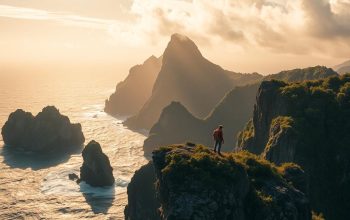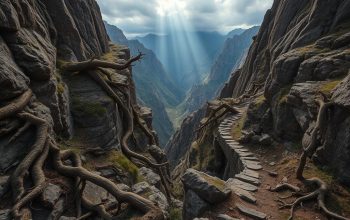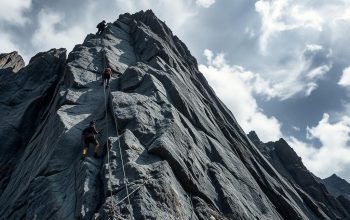Did you know that over 40% of climbers attempting Annapurna in Nepal lose their lives? This is due to altitude sickness and ice wall collapses. Ice climbing is a thrilling winter adventure that requires incredible skill and courage. Destinations like the 450-foot Helmcken Falls in British Columbia, Canada, and the frozen waterfalls of Rjukan, Norway, offer unique challenges and beauty.
In my exploration of these dangerous ice climbing destinations, I will dive into the heart of mountaineering. I will uncover the hidden risks that climbers face, often battling formidable ice formations and harsh weather. As I guide you through these icy arenas, you’ll discover why these locations have earned their notorious reputations and the sheer determination required to conquer them.
Key Takeaways
- Helmcken Falls is known as one of the toughest climbs in the world, standing at 450 feet.
- Rjukan, Norway features frozen waterfalls that can be several meters thick.
- Over 100 ice climbing routes are available in the Canadian Rockies, varying in difficulty.
- Climbing Annapurna presents extreme risks, with a high fatality rate due to altitude sickness.
- Mount Washington has seen over 100 climber deaths, often due to harsh temperatures.
- The scenery of ice climbing environments is breathtaking, yet perilous, requiring utmost caution.
- Conditions are rapidly changing, making daily assessments of climbing safety critical.
Top Destinations for Ice Climbing and Their Dangers
Ice climbing in frozen waterfalls offers stunning views and exciting challenges. Each spot has its own beauty and dangers. For those looking for a winter thrill, here are some top places for ice climbing.
Helmcken Falls Spray Cave, British Columbia, Canada
Helmcken Falls, known as “Wolverine,” is 450 feet tall. It creates amazing ice formations. Climbers face steep routes, perfect for those who love a challenge.
The deep ice hole and large ice daggers are big risks. Climbers must be careful to avoid these dangers.
Rjukan, Norway
Rjukan is a top ice climbing spot with over 190 frozen waterfalls. The climbing season is from November to March. This gives adventurers a long time to practice.
The area is beautiful but also has climbing hazards. Climbers need to prepare well to stay safe.
Canadian Rockies
The Canadian Rockies, like Jasper National Park, offer great climbing spots. The scenery is breathtaking, with many frozen waterfalls. It’s a great place for a memorable ice climbing trip.
Knowing how to use ice climbing gear and safety measures is key. The area can have unexpected dangers.
The Risks of Ice Climbing in Extreme Conditions
Extreme ice climbing is both beautiful and dangerous. Climbers face serious risks, like in high places like Annapurna, Nepal.
Annapurna, Nepal
Annapurna is known for being very deadly for climbers. It’s important to know the dangers of rockfalls and ice walls collapsing. The high altitude and cold are also major threats.
Heavy snowfall makes climbing even harder during the season. Climbers need to be aware of these dangers before attempting to climb.
Cerro Torre, Southern Patagonian Ice Field
Cerro Torre in Patagonia is stunning but dangerous. Climbers face sudden weather changes and avalanches. The snow depth changes a lot at higher elevations.
Knowing how to manage risks and having the right gear is key. Climbing Cerro Torre requires careful planning and preparation.
Mount Washington, New Hampshire, U.S.
Mount Washington has some of the worst weather. Climbers face fast temperature drops and strong winds. The weather can change quickly, making ice formations unstable.
Equipment failure is a big risk due to the cold and changing conditions. Climbers must check their gear carefully. It’s important to assess your skills and the environment before climbing.

Conclusion
My journey through the world’s most thrilling ice climbing spots has ended. I now deeply appreciate the stunning yet dangerous climbs found at places like Helmcken Falls and Annapurna. Ice climbing tests not just physical strength but also mental toughness against nature’s unpredictability.
A 2017 study showed a high injury rate of 9.8 per 1,000 hours. This highlights the importance of safety in ice climbing. Knowing how to stay safe is critical.
Most injuries come from falling ice. This makes following safety rules a must. Half of all injuries affect the head and face, often mildly. But these numbers show the need for safety, even for intermediate climbers.
The thrill of climbing ice is huge, but it comes with risks. Yet, this is what draws people to it. Climbers are drawn to the challenge and the beauty of ice.
For those thinking about ice climbing, preparation and respect for ice are key. Facing fears and physical limits is part of the journey. But knowing the risks is just as important.
The beauty of ice climbing is undeniable. It attracts climbers to places where danger and beauty meet. This is what makes ice climbing so alluring.



